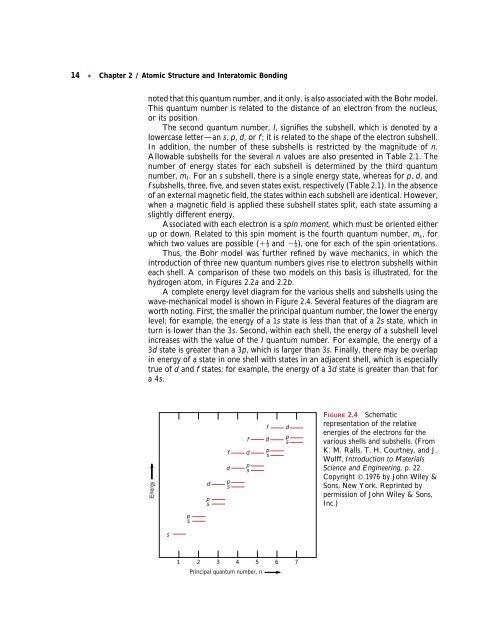Chapter 2 / Atomic Structure and Interatomic Bonding
Chapter 2 / Atomic Structure and Interatomic Bonding
Chapter 2 / Atomic Structure and Interatomic Bonding
Create successful ePaper yourself
Turn your PDF publications into a flip-book with our unique Google optimized e-Paper software.
14 ● <strong>Chapter</strong> 2 / <strong>Atomic</strong> <strong>Structure</strong> <strong>and</strong> <strong>Interatomic</strong> <strong>Bonding</strong><br />
noted that this quantum number, <strong>and</strong> it only, is also associated with the Bohr model.<br />
This quantum number is related to the distance of an electron from the nucleus,<br />
or its position.<br />
The second quantum number, l, signifies the subshell, which is denoted by a<br />
lowercase letter—an s, p, d, orf; it is related to the shape of the electron subshell.<br />
In addition, the number of these subshells is restricted by the magnitude of n.<br />
Allowable subshells for the several n values are also presented in Table 2.1. The<br />
number of energy states for each subshell is determined by the third quantum<br />
number, m l. For an s subshell, there is a single energy state, whereas for p, d, <strong>and</strong><br />
f subshells, three, five, <strong>and</strong> seven states exist, respectively (Table 2.1). In the absence<br />
of an external magnetic field, the states within each subshell are identical. However,<br />
when a magnetic field is applied these subshell states split, each state assuming a<br />
slightly different energy.<br />
Associated with each electron is a spin moment, which must be oriented either<br />
up or down. Related to this spin moment is the fourth quantum number, m s, for<br />
which two values are possible (<strong>and</strong> ), one for each of the spin orientations.<br />
Thus, the Bohr model was further refined by wave mechanics, in which the<br />
introduction of three new quantum numbers gives rise to electron subshells within<br />
each shell. A comparison of these two models on this basis is illustrated, for the<br />
hydrogen atom, in Figures 2.2a <strong>and</strong> 2.2b.<br />
A complete energy level diagram for the various shells <strong>and</strong> subshells using the<br />
wave-mechanical model is shown in Figure 2.4. Several features of the diagram are<br />
worth noting. First, the smaller the principal quantum number, the lower the energy<br />
level; for example, the energy of a 1s state is less than that of a 2s state, which in<br />
turn is lower than the 3s. Second, within each shell, the energy of a subshell level<br />
increases with the value of the l quantum number. For example, the energy of a<br />
3d state is greater than a 3p, which is larger than 3s. Finally, there may be overlap<br />
in energy of a state in one shell with states in an adjacent shell, which is especially<br />
true of d <strong>and</strong> f states; for example, the energy of a 3d state is greater than that for<br />
a4s.<br />
Energy<br />
s<br />
1<br />
p<br />
s<br />
d<br />
p<br />
s<br />
p<br />
s<br />
p<br />
s<br />
Principal quantum number, n<br />
f<br />
d<br />
f<br />
d<br />
f<br />
d<br />
p<br />
s<br />
d<br />
p<br />
s<br />
2 3 4 5 6 7<br />
FIGURE 2.4 Schematic<br />
representation of the relative<br />
energies of the electrons for the<br />
various shells <strong>and</strong> subshells. (From<br />
K. M. Ralls, T. H. Courtney, <strong>and</strong> J.<br />
Wulff, Introduction to Materials<br />
Science <strong>and</strong> Engineering, p. 22.<br />
Copyright © 1976 by John Wiley &<br />
Sons, New York. Reprinted by<br />
permission of John Wiley & Sons,<br />
Inc.)



